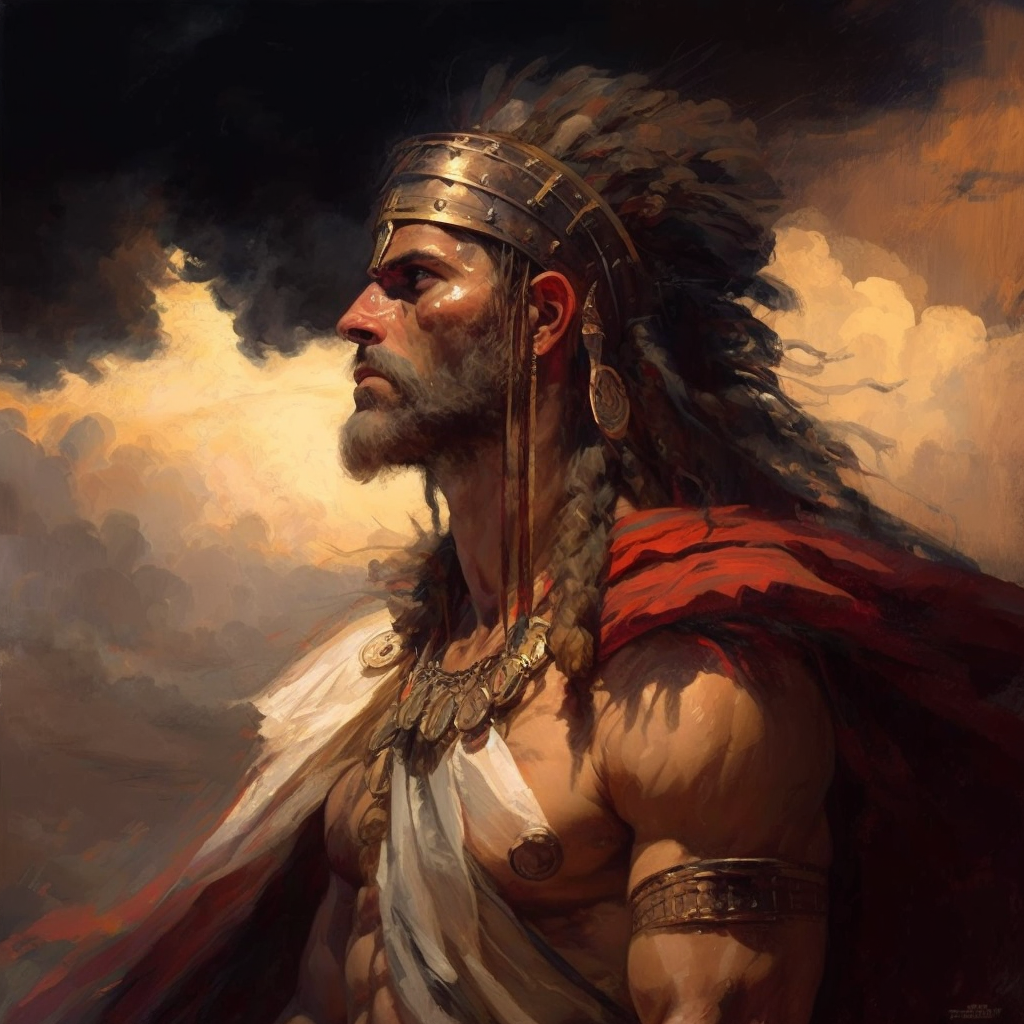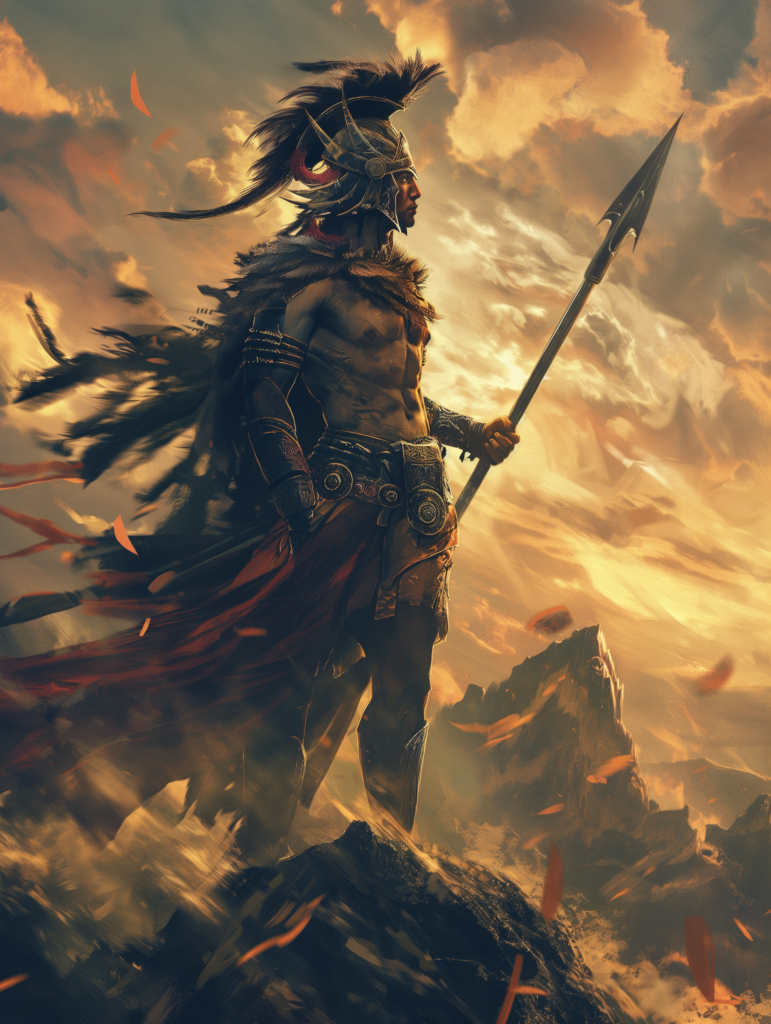Ninurta, “God of War, Agriculture, and Wisdom”
Ninurta is a god in ancient Mesopotamian mythology associated with agriculture, war, and the city of Nippur.

- Pantheon: Mesopotamian pantheon
- Deity Title: God of War, Agriculture, and Wisdom
- Deity Symbol: Bow and arrow, plow, sickle
- Home Plane: Unknown
- Deity Level: Intermediate
- Alignment: Lawful Good
- Aliases: Ningirsu, Ninib, Nintura, Ningišzida
- Superior: Anu, Enlil, Enki
- Traditional Allies: Inanna, Marduk, Utu, Nergal
- Traditional Foes: Anzu, Asag, Pazuzu
- Divine Artifact: Sháar kí, a magical mace or mallet
- Servants: Anunnaki, igigu, annunaki
- Servitor Creatures: Anzû, Šulak, Siris
- Sacred Animal: Lion
- Manifestations: Thunder, lightning, whirlwind, plow
- Signs of Favor: A successful harvest, victory in battle, protection from illness
- Worshipers: Warriors, farmers, kings, judges, scholars
- Cleric Alignments: Lawful Good, Lawful Neutral
- Specialty Priests: Warriors, farmers, judges, scholars
- Holy Days: New Year Festival, Zagmuk Festival
- Portfolio: War, agriculture, wisdom, judgment, justice
- Domains: War, Knowledge, Plant, Protection, Law
- Favored Weapon: Longbow
- Favored Class: Cleric
- Favored Race: Humans
- Duties of the Priesthood: Defend the weak, protect crops, judge disputes, offer guidance and wisdom
- Major Cult/Temple Sites: The Temple of Ninurta at Nippur, The Temple of Ninurta at Kalhu
- Benefits: Divine guidance and protection, the ability to call upon Ninurta’s strength in battle or judgment, protection from illness and misfortune.
Ninurta is a god of ancient Mesopotamian mythology, known for his association with agriculture, war, and the city of Nippur. As a deity of agriculture, he is said to have brought the first plow to the earth and instructed humans in the art of farming. As a god of war, he was often depicted wielding a bow and arrow, and was believed to protect the city of Nippur from its enemies.
Ninurta is described as a powerful and courageous warrior, with a fierce determination to defend his people and uphold justice. He is often depicted as a muscular figure with broad shoulders and a stern countenance, wearing a horned helmet and holding a weapon in his hand.
Ninurta’s actions are motivated by his desire to ensure the prosperity and safety of his people. He is a protector of the weak and a champion of justice, always willing to stand up against those who would seek to do harm. He is known to be a shrewd strategist, using his intelligence and cunning to outmaneuver his opponents on the battlefield.
Ninurta is a muscular god with broad shoulders, a stern countenance, and a horned helmet. He is often depicted holding a weapon, such as a bow and arrow, and exudes an air of strength and power.
Overall, Ninurta is a powerful and respected deity in Mesopotamian mythology, admired for his bravery, intelligence, and dedication to his people. His legacy endures to this day, as his image and story continue to be celebrated in art and literature around the world.
Ninurta, God of War and Agriculture

Large Deity, Lawful Good
Armor Class: 25 (natural armor)
Hit Points: 800 (40d20 + 400)
Speed: 60 ft., fly 120 ft. (hover)
| STR | DEX | CON | INT | WIS | CHA |
|---|---|---|---|---|---|
| 30 (+10) | 20 (+5) | 30 (+10) | 20 (+5) | 30 (+10) | 25 (+7) |
Saving Throws: Str +18, Dex +13, Con +18, Int +13, Wis +18, Cha +15
Skills: Insight +18, Perception +18, Religion +13
Damage Resistances: bludgeoning, piercing, and slashing damage from nonmagical attacks
Damage Immunities: radiant, thunder; bludgeoning, piercing, and slashing from nonmagical attacks
Condition Immunities: charmed, frightened, paralyzed, petrified
Senses: truesight 120 ft., passive Perception 28
Languages: All, telepathy 120 ft.
Challenge: 35 (250,000 XP)
Divine Awareness: Ninurta knows if he hears a lie.
Divine Strength: Ninurta’s attacks deal an extra 21 (6d6) radiant damage.
Legendary Resistance (3/Day): If Ninurta fails a saving throw, he can choose to succeed instead.
Magic Resistance: Ninurta has advantage on saving throws against spells and other magical effects.
Magic Weapons: Ninurta’s weapon attacks are magical.
Multiattack: Ninurta can use his Fearsome Presence. He then makes three attacks: one with his divine weapon and two with his Thunderous Strike.
Divine Weapon: Melee Weapon Attack: +18 to hit, reach 15 ft., one target. Hit: 28 (4d8 + 10) slashing damage plus 21 (6d6) radiant damage.
Thunderous Strike: Melee Weapon Attack: +18 to hit, reach 15 ft., one target. Hit: 24 (4d6 + 10) thunder damage. The target must succeed on a DC 25 Strength saving throw or be pushed up to 10 feet away and knocked prone.
Fearsome Presence (Recharge 5–6): Each creature of Ninurta’s choice that is within 120 feet of him and aware of him must succeed on a DC 25 Wisdom saving throw or become frightened for 1 minute. A frightened creature can repeat the saving throw at the end of each of its turns, ending the effect on itself on a success.
Divine Regeneration: Ninurta regains 30 hit points at the start of his turn. If he takes radiant damage, this trait doesn’t function at the start of his next turn. Ninurta dies only if he starts his turn with 0 hit points and doesn’t regenerate.
Actions
Call Lightning (Recharge 6): Ninurta targets a point he can see within 120 feet of him. A bolt of lightning flashes down from the cloud to that point. Each creature within 5 feet of that point must make a DC 25 Dexterity saving throw, taking 21 (6d6) lightning damage on a failed save, or half as much damage on a successful one.
Divine Wrath (Costs 2 Actions): Ninurta can release a powerful burst of divine energy in a 60-foot radius around him. Each creature in that area must make a DC 25 Constitution saving throw, taking 63 (18d6) radiant damage and 63 (18d6) thunder damage on a failed save, or half as much damage on a successful one.
Region Effects
Ninurta’s Domain
- Crops within a 1-mile radius of Ninurta’s temple grow with incredible speed, maturing in half the time it would normally take.
- Thunderstorms are more frequent in the area, occurring once per week on average. These storms often bring heavy rain, benefiting agricultural endeavors.
- People within the domain feel a sense of protection and guidance, bolstering their resolve and granting advantage on saving throws against fear effects.
Currently
Ninurta is a powerful god, revered by many for his wisdom, strength, and courage. During the 1450s, he remains a guiding force in the lives of his followers, offering them guidance and protection during tumultuous times.
As the world around him undergoes significant changes, Ninurta is called upon to help maintain the balance of power. He watches as empires rise and fall, conflicts flare up and are resolved, and new civilizations emerge from the ashes of the old. Throughout it all, he remains steadfast in his commitment to justice and the well-being of his people.
At times, Ninurta must intervene directly in the affairs of mortals, using his powers to tip the scales in favor of those who have been wronged. He inspires his followers to fight for what is right, even in the face of overwhelming adversity. His mere presence on the battlefield is enough to strike fear into the hearts of his enemies, who know that they are facing a deity of immense power and strength.
But for Ninurta, the goal is not simply to win battles or exert his will over others. Rather, he sees himself as a defender of the weak and a champion of justice. He seeks to create a world in which all people can live in peace and prosperity, free from the threats of violence and oppression.
As the centuries pass, Ninurta’s legacy endures, as his followers continue to look to him for guidance and protection. He remains a symbol of strength, courage, and justice, a god who stands up for what is right and inspires others to do the same.

 Buy me a coffee
Buy me a coffee